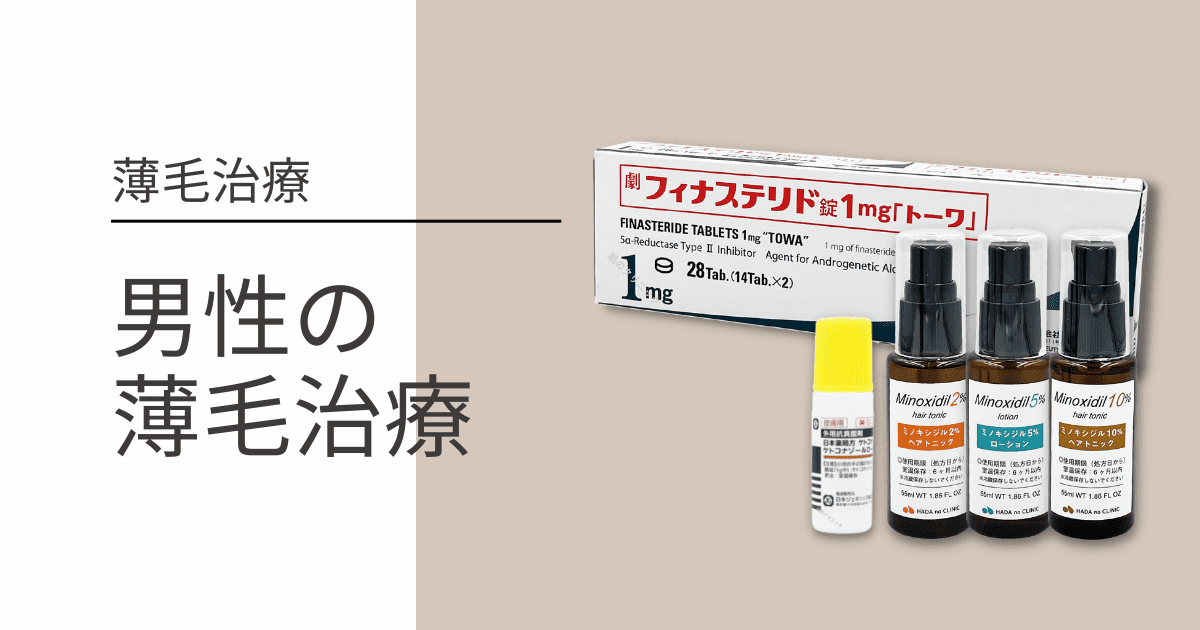What is Female Pattern Hair Loss (FPHL/FAGA)?

Female Pattern Hair Loss (FPHL) is the most common form of diffuse hair loss in women, also known as Female Androgenetic Alopecia (FAGA).
Many women experiencing symptoms like “decreased hair volume,” “more visible part lines,” or “visible scalp at the crown” are suffering from FPHL.
Epidemiology of FPHL: Surprisingly Common in Younger Women
According to the American Academy of Dermatology (AAD), FPHL begins in women as young as their teens to 40s. Approximately 12% of women around age 30 and over 30% of women above 60 develop this condition. In Japan, 1 in 10 women in their 30s experiences hair concerns, highlighting the importance of early intervention.
Characteristic Symptoms
The primary symptoms of FPHL are decreased hair density and miniaturization of hair strands, particularly at the crown and part lines. Similar to male pattern baldness (AGA), the occipital (back of head) region typically remains less affected.
Main Causes: Hormonal Balance and Hair Cycle Changes
In healthy hair growth, 85-90% of scalp hair is in the growth (anagen) phase, developing slowly over 2-6 years. The remaining 10-15% passes through regression (catagen) and resting (telogen) phases before shedding naturally after about 3 months.
FPHL shortens this hair cycle, particularly the growth phase, resulting in thinner, shorter hairs. The primary cause is believed to be increased hair follicle sensitivity to dihydrotestosterone (DHT). Additionally, hormonal changes from birth control pills, pregnancy, or postpartum periods can trigger FPHL.
Specialist Diagnosis Methods
FPHL is typically diagnosed through detailed medical history and visual examination. For more precise diagnosis, specialists may use:
Dermoscopy Examination
Assesses variations in hair shaft thickness and increased vellus hair in affected areas. FPHL is diagnosed when over 20% of hairs show differences in shaft thickness.
Hair Pull Test
Involves gently pulling hair strands to check which types come out. In telogen effluvium, mostly thicker hairs are extracted, while in FAGA, nearly half of extracted hairs are shorter and thinner.
Blood Tests
May be performed to check for conditions that can cause hair thinning, including hormonal imbalances, thyroid dysfunction, low ferritin, vitamin D deficiency, and polycystic ovary syndrome (PCOS).
- Hirsutism (excessive body hair)
- Tendency toward obesity
- Increased acne
- Abnormal uterine bleeding
- Irregular menstruation
- Galactorrhea (milk secretion)
- Infertility, Hyperglycemia
Female Hair Loss Treatment: Evidence-Based Effective Therapies
Treatment Case Study
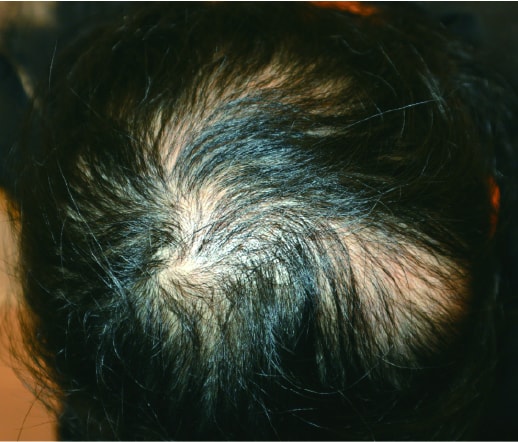
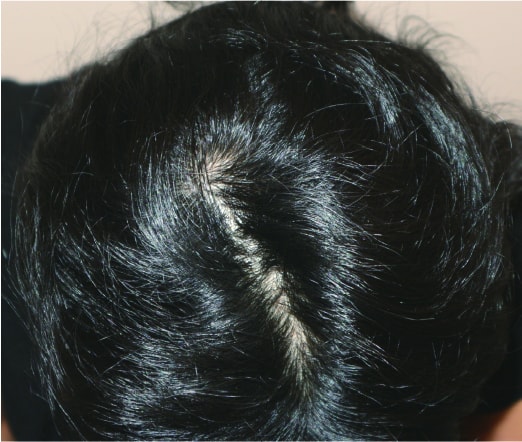
Case study of a woman in her 40s treated at our clinic with spironolactone and minoxidil tablets. With minoxidil tablet treatment, significant hair regrowth typically occurs after about 6 months. While body hair may also become thicker as a sign the treatment is working, most patients find this manageable. For those concerned about increased body hair, medical hair removal is an option to consider.
Treatment Options for Female Hair Loss
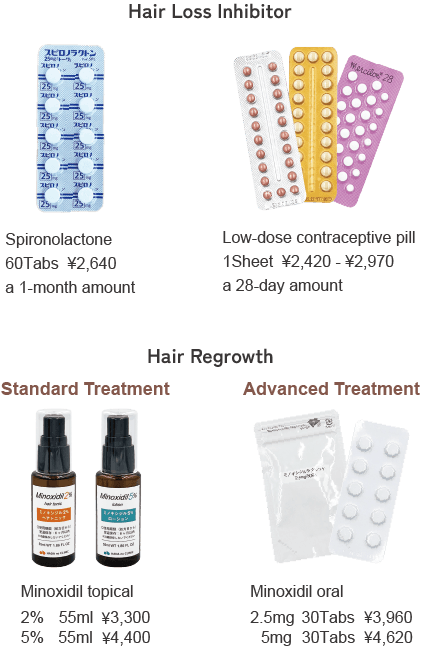
Standard Treatment
Our standard treatment for FPHL combines spironolactone (to suppress male hormones and reduce hair loss) with topical minoxidil (to stimulate hair growth). For more effective results depending on symptom severity and cause, low-dose birth control pills may be added to the regimen.
For information about the effects and side effects of birth control pills and spironolactone, please refer to our Hormonal Acne Treatment page.
Advanced Treatment (Minoxidil Tablets)
For moderate to severe cases, concerns about progressive thinning, or those seeking stronger regrowth results, we prescribe low-dose minoxidil tablets. Regular check-ups are mandatory for side effect management.
For details on topical minoxidil and minoxidil tablets, please see our Male Pattern Baldness (AGA) Treatment page.
Supplementary Therapy: Placenta Injections
Placenta injections serve as a supplementary cosmetic therapy, providing anti-aging benefits for both hair and skin. When combined with hair loss treatment, synergistic effects can be expected.
Special Treatment for Women Over 40: Finasteride
For women over 40 with no pregnancy plans, finasteride may be prescribed. While this medication has proven effective for male pattern baldness, its use in women is strictly controlled under specific conditions. For detailed information, please visit our page “Is Finasteride Effective for Female Hair Loss? (Japanese)”
Female Pattern Hair Loss Treatment Pricing
Medication Pricing
| Medication | Price (tax included) |
|---|---|
| Spironolactone 25mg | 30-day supply (60 tablets) ¥2,640 |
| Low-dose Birth Control Pills | 28-day supply (1 sheet) ¥2,420-2,970 |
| Topical Minoxidil 2% | 1 bottle ¥3,300 |
| Topical Minoxidil 5% | 1 bottle ¥4,400 |
| Oral Minoxidil 2.5mg | 30-day supply (30 tablets) ¥3,960 |
| Oral Minoxidil 5mg | 30-day supply (30 tablets) ¥4,620 |
- One bottle (55mL) of topical minoxidil lasts approximately one month
- These medications are not approved in Japan and are not covered by the Pharmaceutical Adverse Drug Reaction Relief System
- Minoxidil is toxic to dogs and cats – please ensure pets do not lick the solution or come into contact with hands that have applied the product
Standard Treatment Pricing
Example cost for treatment combining Spironolactone 50mg/day and Topical Minoxidil 2%:
Initial Visit (2-month supply)
| Item | Price (tax included) |
|---|---|
| Initial Consultation | ¥3,850 |
| Medication | ・Spironolactone 120 tablets ¥5,280 • Topical Minoxidil 2% 2 bottles ¥6,600 |
| Tests | Blood test ¥2,948 |
| Total (2 months) | ¥18,678 ¥9,339 per month |
Follow-up Visit (4-month supply)
| Item | Price (tax included) |
|---|---|
| Follow-up Consultation | ¥1,650 |
| Medication | ・Spironolactone 240 tablets ¥10,560 • Topical Minoxidil 2% 4 bottles ¥13,200 |
| Tests | – ※1 |
| Total (4 months) | ¥25,410 ¥6,352 per month |
- Spironolactone prescription requires blood tests at the initial visit and once every 6 months to monitor for side effects
- Consultation fees apply for oral medication prescriptions. For topical medication only, appointments are not necessary after the second visit
- We prescribe a 2-month supply at the initial visit to monitor side effects, then a 4-month supply at follow-up if no problems arise, with consultations every 3-6 months thereafter
Advanced Treatment Pricing
Example cost for treatment combining Spironolactone 50mg/day and Minoxidil Tablets 2.5mg:
Initial Visit (2-month supply)
| Item | Price (tax included) |
|---|---|
| Initial Consultation | ¥3,850 |
| Medication | ・Spironolactone 120 tablets ¥5,280 • Oral Minoxidil 2.5mg 60 tablets ¥7,920 |
| Tests | ・Blood test ¥5,148 • Electrocardiogram ¥2,706 • Urine test ¥1,848 |
| Total (2 months) | ¥26,752 ¥13,376 per month |
Follow-up Visit (4-month supply)
| Item | Price (tax included) |
|---|---|
| Follow-up Consultation | ¥1,650 |
| Medication | ・Spironolactone 240 tablets ¥10,560 • Oral Minoxidil 2.5mg 120 tablets ¥15,840 |
| Tests | – ※1 |
| Total (4 months) | ¥28,050 ¥7,012 per month |
- Minoxidil tablet prescription requires tests (blood, electrocardiogram, urine) at the initial visit and once every 6 months
- Consultation fees apply for oral medication prescriptions. For topical medication only, appointments are not necessary after the second visit
- We prescribe a 2-month supply at the initial visit to monitor side effects, then a 4-month supply at follow-up if no problems arise, with consultations every 3-6 months thereafter
Note: Medications cannot be prescribed for pregnant or nursing women (consultation only). Available medications vary depending on existing medical conditions, age, smoking, and other lifestyle factors. Please consult with our doctors during your appointment.
Scalp Micro Pigmentation (SMP)
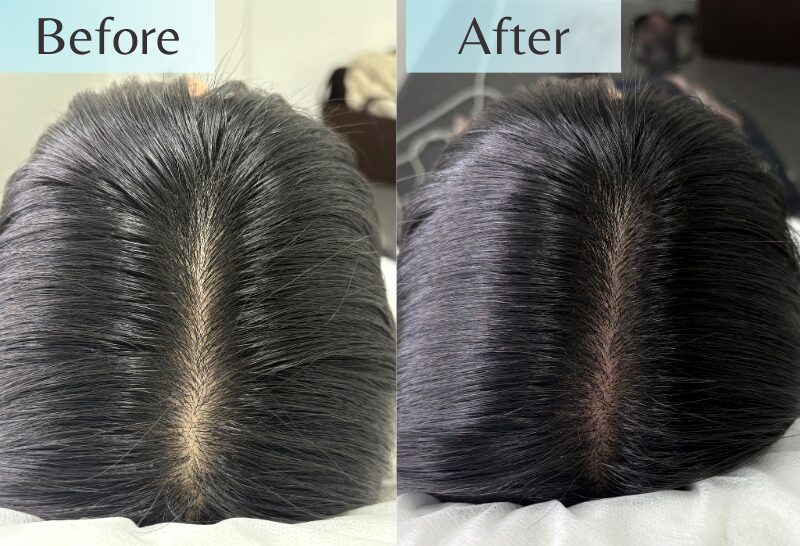
One of the most common concerns for women experiencing hair thinning is visible scalp showing through the hair parting. Scalp Micropigmentation (SMP) is a procedure that applies tiny dots to the scalp in areas of concern, creating the appearance of greater hair density.
SMP provides a natural-looking solution to cover visible scalp at the parting, making it particularly beneficial for those who can’t get immediate results from medication or who prefer not to rely heavily on pharmaceutical treatments.
Recommended for those who:
- Want to reduce the appearance of visible scalp at the parting or crown
- Wish to conceal scalp scars
- Desire immediate visual improvement while using medical treatments
- Prefer not to increase medication usage
Our clinic’s scalp medical artistry emphasizes natural-looking results and longevity. Using high-quality pigments and specialized techniques, we create an appearance that mimics real hair follicles. With an average of three treatment sessions, patients experience significant reduction in visible scalp and renewed confidence.For more detailed information, please visit our Scalp Micropigmentation page (available in Japanese only – please use translation tools).
Frequently Asked Questions About Female Hair Loss Treatment
- What is diffuse hair loss?
-
Diffuse hair loss refers to widespread thinning rather than specific patches. It’s not a single disease but a symptom pattern. Types include female pattern hair loss (FAGA), telogen effluvium, and even widespread alopecia areata.
The most common form is female androgenetic alopecia (FAGA).
- Can over-the-counter hair growth products cure hair loss?
-
No. From a medical perspective, all commercially available hair growth products lack scientific evidence for effectively treating hair loss.
If someone reports improvement with these products, they likely experienced temporary hair loss that would have resolved naturally without treatment.
The only over-the-counter product with medical evidence is the Class 1 pharmaceutical topical minoxidil.
- Is Pantogaŕ effective?
-
Pantogaŕ is essentially a supplement with minimal effects. Our clinic previously prescribed it but discontinued use after observing no clinical benefit in any patients.
- Can the cause of hair loss be investigated?
-
In most cases, hair loss patterns, history, and visual examination can determine the likely cause, though some situations require testing.
While not everyone needs testing, those who’ve never been tested may benefit from it. Our clinic offers two types of tests:
1. Cause Screening Tests (¥14,080 including tax)Evaluates over 30 parameters including thyroid function, anemia markers, vitamin D and zinc levels, internal organ function, and autoimmune indicators.
2. Hormone Tests (¥9,746 including tax)Measures four female hormones and one male hormone.
Note: For accurate hormone testing, patients taking hormone medications or spironolactone should discontinue them at least one month before testing. Pre-menopausal women should schedule morning appointments on days 3-5 of their menstrual cycle (or days 1-7 if necessary).
- Will hair loss return if I stop treatment?
-
Temporary hair loss caused by postpartum hormonal changes, viral infections, vaccination reactions, or alopecia areata may remain improved after treatment ends. However, for FAGA (the most common form of diffuse hair loss), discontinuing treatment will allow progressive, age-related thinning to resume.
- Are hair growth mesotherapy treatments necessary?
-
No. We don’t recommend them due to insufficient scientific evidence.


